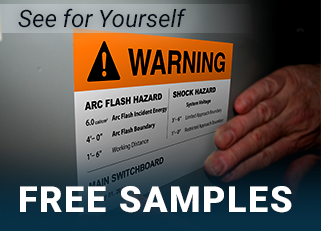Electrical Safety for Humans
03
February,
2023
5 MINUTE READ

There are hundreds of detailed resources on electrical safety. Most of them are written by (and for) electricians. But electricity is a part of daily life for everybody. Normal humans need to know what's going on, too!
A Crash Course in Electricity
Electricity is a form of energy, just like heat, light, and motion. Machines can convert one form of energy into another, using that supply of energy to do something interesting. A motor can use electricity to spin a wheel, while a lamp can use it to light a room.
These applications rely on an ongoing flow of electrical energy, not just a single, momentary zap. To provide an ongoing flow of energy, you need a continuous path for the energy to follow; this is a circuit. Circuits are like pipes carrying water; if there's a problem with the pipes, the water may not flow at all, or it may not flow where you want it.
A generator or a battery would be like a pump for the water. A pump creates suction at the intake and pressure at the output. In the same way, an electrical generator or battery creates a positive electrical charge at one point and a negative charge at another point.
That difference in charge is the pressure that makes energy flow, and that pressure is measured as a voltage. Often, people will refer to "nominal voltage," which just means that the number provided is an estimate or average, rather than being technically accurate at all times. Voltage is counted in volts (V). For scale, a typical AA battery provides about 1.5 volts, while the wall outlets in North American homes provide a nominal 120 volts.
But the pressure is only one part of the system. Another important part is the amount of water that is flowing in the pipes. With electricity, the amount of flow is called current, which is measured in amps (A). Low-powered systems might use milli-amps (mA), or thousandths of an amp, instead. For scale, the current flowing through a hair dryer might be 15 amps, while a typical incandescent ceiling light could use 0.5 amps (or 500 mA) of current.
Big pipes offer an easy path for lots of water, but a pipe that's too narrow can slow down the flow. Similarly, some materials allow electrical energy to flow very easily, while other materials don't. This is called resistance, and is measured in ohms (?). Objects and materials that have low resistance, like wires and other metallic objects, let electricity flow easily and are called conductors. Things with high resistance, like rubber or glass, are called insulators. Resistance along a path adds up, so a long circuit made of a good conductor can still have high resistance.
To describe the relationship between voltage, current, and resistance, electricians refer to a simple formula called Ohm's Law. Simply put, it goes like this: R=V/A. That is, for a given part of a circuit, resistance (in ohms) is equal to the voltage (in volts) divided by current (in amps). Since this is algebra, you can also say that V=R?A, and A=V/R. The basic relationship among the units is that a voltage of one volt will push a current of one amp through a circuit with one ohm of resistance.
Not My Fault: Electrical Accidents
When water pipes burst and the water goes where it doesn't belong, it's a big mess. People can get hurt, the property can be destroyed, and a whole lot of water gets wasted. The same kind of thing can happen when electricity goes the wrong way. We call this an electrical fault.
Let's say you drop a metal wrench across a couple of exposed wires; that wrench might form a much shorter, less resistant path for the energy, compared to the intended circuit. Suddenly, you have a couple of hundred amps flowing through your wrench. This is a problem!
This kind of electrical fault, a "short circuit," is inconvenient, expensive, destructive, and dangerous. Lots of energy is diverted, following a path that doesn't do anything useful. Electrical equipment can be ruined by the unexpected change in current. Objects that weren't meant to conduct electricity in the first place can get very hot when they carry a strong electrical current, and that's what causes an electrical fire. Most dramatically, if you tried to pick up that wrench, your body might form a new path for the electricity, leading to injury or even death.
In comparison to the amounts of electric current that we use on a daily basis, the human body is pretty sensitive to electricity. You can feel a current of about 1-5 mA, and only a little bit more can make your muscles clench uncontrollably - preventing you from letting go of the thing that you shouldn't have touched. When it hurts or harms you, electric current passing through your body is called electric shock.
Current moving through an object that offers resistance (like a human body) will raise the temperature of that object, and strong electrical current can cook skin and organs in a matter of seconds, causing electrical burns. And between 30 and 300 mA of electricity passing across your chest can cause fibrillation, in which the different bits of the heart fall out of rhythm and effectively stop working. Remember that ceiling light that ran on 500 mA? Definitely enough power to kill you.
It's also possible for the energy to jump across a gap of air, instead of following paths through solid conductors. Dry air has a very high resistance, so as long as there's a gap of air between two conductors, almost no current can flow that way. If that gap of air shrinks, though, the resistance along that path will drop as well. When the resistance gets low enough, a sudden burst of current can bridge that gap, creating an arc. If an electrician drops a tool, or if a mouse gets into the equipment and stands in the wrong place, the air gap can shrink very quickly.
If there's a continuous source of energy, the current in an arc might continue to flow, getting more and more powerful. An industrial arc welder uses this intentionally, to permanently bond metal parts by melting them together. When it happens by accident, the same power is there, but without any control. This is the basis of an arc flash, a type of electrical accident that can end up looking like a bomb went off. About 2000 people are hospitalized every year with burns from arc flashes.
What Can You Do?
Naturally, nobody wants to experience a horrible electrical accident. But apart from joining the Amish, there aren't many ways to get away from electricity entirely. Instead, you can follow some standardized practices for electrical safety.
First, there's the National Electrical Code (NEC), which is published by the National Fire Protection Association (NFPA). This code describes accepted installation requirements for electrical systems, ensuring that homes and businesses are wired safely. The standard has been adopted into law in most of the United States and is well-respected by electricians and other experts. Electrical systems should always be installed according to the requirements of the NEC or a similar standard.
After installation, electrical systems often need to be modified or maintained. Whenever possible, power down an electrical circuit completely before adding, removing, or servicing any components on that circuit. This can be as simple as turning off the switch when changing a light bulb. For larger equipment, common in industrial workplaces, safety requires a lockout/tagout (LO/TO) system. In this approach, the power is shut off, the system is checked to make sure that the power is really off, and then the power supply is locked so it can't be turned on again. Each worker who could be affected applies their own lock, and removes it only when done with their work. This way, there's no uncertainty, and the system remains powered down until everyone is in the clear.
When powering down the system isn't possible, or introduces some other hazard, special precautions are needed. These steps are described in another standard from the NFPA, called NFPA 70E, the Standard for Electrical Safety in the Workplace. NFPA 70E describes recommended practices for maintaining and servicing electrical equipment, and protective procedures and equipment for workers to use.
Effective labeling on an electrical system is an important step, because labels allow you to have the information you need, when you need it, where you need it. Your circuit breaker box at home might have each switch labeled with the room that it controls; heavy equipment at your workplace might have operating and shutdown procedures marked right on the control panel. The NFPA standards call for special labels in other circumstances. Most importantly, all of these labels are intended for humans to read, so they should make sense to the humans involved.
RELATED RESOURCES

Understanding Arc Flash: The Shocking Truth About Electrical Injuries
Electrical workers consider shocks as part of their job and normal, according to a study. However, it could ...
Read
5 Shocking Arc Flash Mistakes
Everyone knows arc flash is dangerous and the hazards that come with electrical work. However, sometimes ...
Read
The Survivor's Guide to Arc Flash Safety
On Thursday, August 12, 2004, electrical contractor Donnie Johnson's day began like any other. However, the ...
Read.png)


